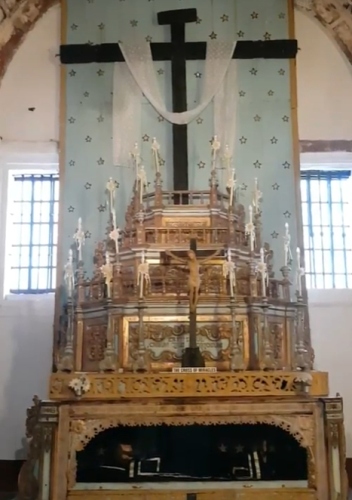According to one legend, some shepherds who would take their cattle for grazing on this hill had made a Piddeancho Khuris there, from a piece of coconut palm trunk, 3 ½ yards in length. Yet another legend states that Fr Manuel Rodrigues, priest of the Sé Cathedral, had put a teak wood cross on the rock. This cross could be seen from as far as Divar island

The Miraculous Cross is now at the Se Cathedral in Old Goa.
The feast of Cruz dos Milagres (Miraculous Cross) will be celebrated today at St Joseph Vaz Spiritual Renewal Centre, Old Goa, to commemorate a spectacular phenomenon that took place at the site on this day in 1619.
The Masses will be celebrated in Konkani at 6 am and 8 am, while Archbishop Filipe Neri Ferrao will preside over the Mass at 10 am. A Mass in English will be celebrated at 6 pm. “Pez” will be served after every Mass.
According to one legend, some shepherds who would take their cattle for grazing on this hill had made a Piddeancho Khuris there, from a piece of coconut palm trunk, 3 ½ yards in length.
Yet another legend states that on February 23, Fr Manuel Rodrigues, priest of the Sé Cathedral, had put a teak wood cross on the rock. This cross could be seen from as far as Divar island.
Some people who were returning home after night adoration at St Mathias Church, Divar, saw a strange light around the Cross. They did not pay much attention to it, thinking it to be the light of the huge comet that had appeared on the Goan skies earlier. But there was a difference in this light, the light from the Cross was suave, beautiful and radiant in comparison to the frightening light of the comet.
Later, some passers-by saw a vision on the Cross. They saw a man on the Cross, which was shaking from left to right. His head was upwards, his open arms nailed one over the other by a single nail to the Cross; there was also a towel around his waist and the body covered with wounds and stained with blood, a crown of thorns around the head.
There was a red halo around as big as a round hat, which was shining brilliantly. From the midst of this hallo, was also seen a small red flag as big as a handkerchief drifting fast at the mercy of the wind, like that of a gale. The cross had grown to 5 and ½ yards and to stop people from taking its pieces, it was wrapped in a red velvet and encased in another Cross.
News of this vision spread like wildfire and soon, thousands of people of all faiths rushed to the Cross but when they reached there, the vision had disappeared. Many people are said to have begun doing penances, many hardened sinners changed their lives. People brought their sick to the Cross, and many were healed. Everyone who had reached the hill wanted to take a relic of the Cross.
This news reached the doorstep of the Archbishop of Goa, Dom Cristovão de Sa e Lisboa (1613 – 1622), who immediately appointed a committee that included canons and the chief public functionaries (medical men and lawyers) to study this phenomenon.
The Archbishop also ordered the Cross to be conveyed in a solemn procession on the shoulders of canons and the chief public functionaries to the neighbouring Church of Our Lady of Light, Nossa Senhora de Luz, which does not exist today.
The Committee reported that the phenomena that had taken place on that hill were true, and the one who had appeared on the Cross was the Body of the Crucified Christ. The miracles too that had taken place there were supernatural. Consequently, a solemn feast was celebrated in the Cathedral.
A new church was built on the site where the Holy Cross stood, and the Cross was placed in it, which unfortunately collapsed on August 8, 1659, due to the poor quality of material used for construction. The Cross was then taken to the Church of Our Lady of Light. It was only when a new church was built at the same site by an Augustine friar (1669) and completed in 1671 that the Cross was moved into it.
In 1835, when all the religious orders and congregations were suppressed by the Portuguese government in Goa, the Miraculous Cross was transferred in a solemn procession to the Cathedral Church on May 3, 1845 by orders of the Governor, Jose Ferreira Pestanha. It is here that one can find the Cross even today which is inaccessible to the public.
(The writer is Superior at Casa Professa, Basilica of Bom Jesus in Old Goa)